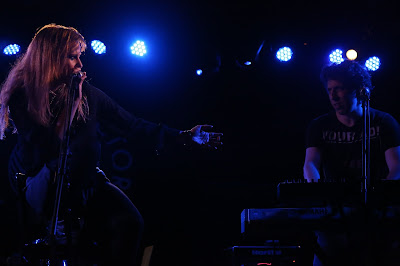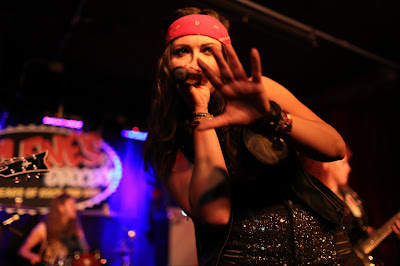 |
| Press photo by Rob Tannenbaum, courtesy of the artist |
Looking for music that will revitalize your creative energy in these precious lingering moments of summer? Val Yuri’s electronic EP Katharsis is lush with shifting textures and cresting with artistic potential. Considering the path she’s walked, starting as a singer in Ukraine as a child, switching to the business end of the industry as a young adult, and now designing audio for games and cinema, it is fitting that this EP reaches for so many different corners of the vast electronic genre while still maintaining a commercially sound core.
The EP opens with “Largesse,” an urgent melodic periscope that shatters into beads of light pelting a windowpane as a spidery fuzz crawls low between the treble splashes. The varied number is spotted with a cast of unexpected percussive sounds that creep in and fade out like strange creatures scuttling across the ocean floor. Out of the electronic abyss, a psychedelic guitar picks out rippling notes that weave around a quixotic bell keyboard, moving the track into jazzier territory to end the song on a literal high note. The following track, “Oceans,” goes deep and dark into a 90s cyberpunk aesthetic. Collegiate goth rock drips with threatening bass notes and breathy vocals that flutter, carrying lyrics that rise slowly to clarity throughout the song, akin to something being lifted from murky waters. The first two thirds of the song swoops low on the scale, sharklike notes cutting just under the eerie green radar of the spectral mantra at the heart of the number.
The titular third track is introduced with industrial found sounds and punctuated with pockets of silence that dissolve into spacey metallurgy made audible. “Katharsis” is an ideal combination of compelling and nonchalant; music that can be in the foreground or background of an environment and enjoyed either way. The song propels itself forward on thrusting rock rhythms and then hangs back to bask in gritty warehouse electronica like it’s 1996. The theatrical piece takes detours through discordant deserts of steely rumbles and the traffic of Floydian alarms. Playful sliding tones float like sticky bubbles around the trap hop beat that steers the number to a halting finish.
The fourth track, “Here Tonight,” crawls out of the darkness with the soft pop vocals of rising featured artist Lydia Lyon, her voice slightly smudged beneath a violet filter as she scales the rigid terrain of digital beats that curtain the occasional recognizable instrument. Closing track “Set You Free” feels like opening the lid of a music box found in the home of the Halliwell sisters; new age and mystic tones paint a sense of nostalgia for something dreadful in your attic. Dreamy and pleasantly haunting, the song dances over a piano bridge and down a clunky spiral as the sole lyric steadily charges it with a supernatural energy.
 |
| EP Artwork by Catalina Piedrahita |
Val Yuri was kind enough to talk to me a little about her musical background and how she goes about the business of composing and performing. Below is our interview, conducted over email and edited only for grammar.
HJ: Tell me about your musical influences. Which artists first inspired you to write music? Who do you admire or emulate?
VY: I started as a jazz performer studying the likes of Ella Fitzgerald and George Gershwin. Growing up in Ukraine in the 90s, I heard jazz for the first time when I was about 7 years old. I listened in on a big band rehearsal after a class at my music school and immediately felt like that was where I saw myself. Jazz was gaining significant mass appeal in those first years of the Post Soviet [era] and I ended up catching the wave as one of the youngest performers in the genre. Over the years, I have explored almost every [style] out there, and I currently aspire to write music that falls between Amon Tobin, Radiohead, Coldplay and Phoenix.
HJ: Tell me about your musical training. What and when did you start playing or singing?
VY: I started taking piano and vocal lessons when I was 5 years old. From about 7, I was full time at a music school where I was also learning theory, singing in a choir and getting the foundation for the formal education to come. I moved to the U.K. when I was 14 and at 15 I got accepted to Berklee College of Music in Boston, where I pursued a degree in Music Business and Management.
HJ: What is your process for composing an instrumental track? Where does your inspiration come from to write instrumental tracks?
HJ: What is your process for composing an instrumental track? Where does your inspiration come from to write instrumental tracks?
VY: I feel like instrumental tracks give more way to interpretation and that is what I like the most about writing music with no vocals and lyrics, and what inspires me the most as a writer. Even when I write melodies for vocals I tend to focus more on the textural elements of the timber of the voice in combination with how the words sound and not only what they mean. What inspires me the most about electronic music is that I can create textures and sounds that have never been heard before. Using that to make the listener more aware of his subjective experience is definitely one of my favorite ways to engage as an artist.
HJ: Do you do live shows? How does a live show compare to making music in the studio with regards to this genre?
VY: The gamut of technology that can be used for a live show is as sophisticated as studio equipment. You can manipulate almost every property of a sound in real time which quite literally helps you create a one of a kind performance every time. The way I see it, studio is all about control on a microscopic level, but live performance is about expressing yourself in the moment and taking chances, which is very similar to improvisation in a lot of ways and something that is a big part of me.
HJ: Can you tell me about the inspiration behind Katharsis specifically? What was it like composing this EP? What is your favorite track and why?
VY: Katharsis was an experiment in a lot of ways. My goal was to create an electronic film score that had no visuals dictating the plot. The structure of each song was driven by an imaginary story line that is there to provide a rhythm and overall direction but I wanted to let it be up to the listener to define what it means. My favorite track on the record would have to be “Oceans,” simply because I sketched out the idea for the song when I just moved to the U.S., so essentially it is about feeling out of place and making sense of distance, which are two very personal themes for me.
 |
| Press photo by Rob Tannenbaum, courtesy of the artist |
HJ: Is it more difficult to gain listeners with a heavily instrumental EP than with the typical formula that balances music and lyrics? How does the popularity of this work measure against the popularity of your more traditional songwriting approaches?
VY: With the traditional major label structure dissolving, I find that more and more people are drawn to experimental records, which includes a lot of instrumental music. So there are definitely more options for non-traditional artists to reach accessibility than ever before. It comes down to two kinds of consumers and two kinds of success: one where a lot of people buy one single or one where fewer people buy packages that might include the album, merch and other bonus material, and which tend to be more expensive to buy. It is really up to the artist what kind of following they are looking to build. So in terms of exposure, vocal pop writing will always have a leg up on any other style, and I absolutely enjoy writing in that medium, but mass popularity sometimes comes at the expense of longevity.
HJ: What is your next move? Shows, tours, recording, writing, etc?
VY: I am releasing a new single in the next couple of months. It is probably the closest I’ve gotten to finding a happy medium between alternative and commercial, so I am definitely very much excited to see the reaction. I am taking a break from solo performance to work on a new EP, but I do have a few performances lined up with Late Nite Cable, a synth pop band. Go to http://latenitecable.com/ for more info.
Fans of film scores and 90s electronic groups like Portishead and Laika should definitely give Katharsis a listen, and artistic types are sure to find the rapid changes and rich sonic landscape inspiring. Play the EP below and keep an eye on Val Yuri’s projects here.
























